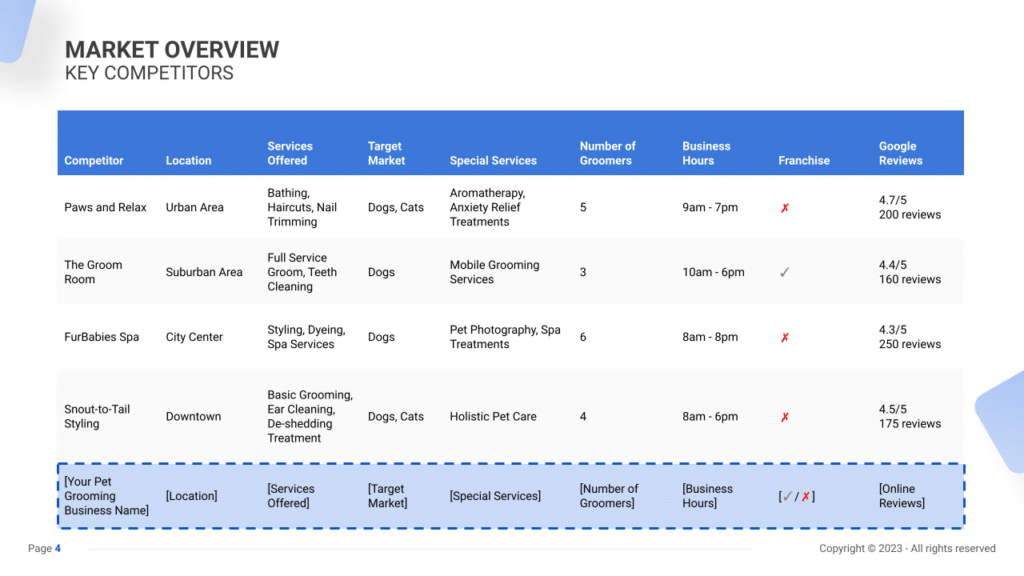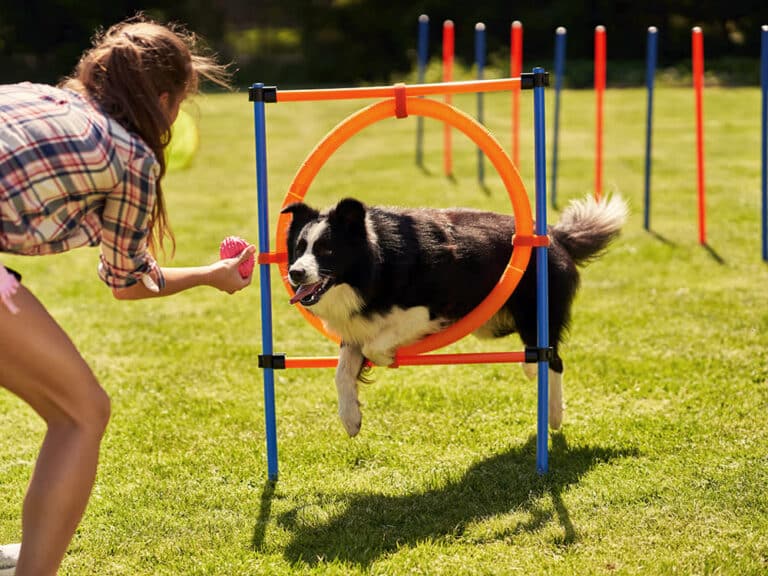Competitive Analysis for a Pet Grooming Business (Example)

A competitive analysis is not just a tool for gauging the position of your pet grooming business in the market and its key competitors; it’s also a fundamental component of your business plan.
This analysis helps in identifying your pet grooming business’s unique selling points, essential for differentiating your business in a competitive market.
In addition, the competitive analysis is integral in laying a solid foundation for your business plan. By examining various operational aspects of your competitors, you gain valuable information that ensures your business plan is robust, informed, and tailored to succeed in the current market environment.

Identifying Your Competitors in the Pet Grooming Industry
The first step in a competitive analysis is identifying your competitors. Start by listing local pet grooming services. For example, if your service specializes in grooming large breeds, your direct competitors include nearby pet grooming businesses that offer similar services, as well as pet stores that provide grooming. Don’t forget indirect competitors such as mobile grooming services or pet sitters who also offer grooming as part of their services.
Utilize online tools like Google Maps to understand the geographical distribution of competitors. Platforms like Yelp and Google Reviews offer customer reviews and ratings, which shed light on the strengths and weaknesses of these competitors. For instance, if several reviews praise the gentle handling and stylish cuts at “Pampered Paws,” this highlights a key strength of your competitor.
Pet Grooming Competitors’ Strategies
Analyzing the strategies of competitors involves looking at several factors:
- Service Offerings: Review the range of grooming services they provide. If “Eco Groomers” is becoming popular for its use of organic and hypoallergenic products, it might suggest a market shift towards environmentally conscious pet care.
- Grooming Techniques: Assess the grooming techniques and styles used. A service like “Classic Cuts” that offers traditional grooming styles might attract a different clientele compared to “Trendy Tails,” known for creative and fashionable pet hairstyles.
- Pricing Strategy: Compare your pricing with that of competitors. Are your services priced competitively with “Affordable Pet Care,” or do they align more with the high-end services at “Luxury Pets”?
- Marketing Tactics: Examine how competitors market their services. Do they have a strong online presence, or do they engage more with the local community through events and partnerships?
- Customer Experience: Evaluate the customer service experience. For instance, “Friendly Fur” might be recognized for its welcoming staff and comfortable waiting areas, which enhance the overall customer experience.
- Operational Efficiency: Look at whether competitors use technology or innovative practices to make appointments and services more efficient, such as “Quick Clips” with its online booking system.
What’s Your Pet Grooming Business’s Value Proposition?
Reflect on what makes your pet grooming business unique. Perhaps you are renowned for your expert handling of sensitive pets, or maybe you offer a mobile grooming service that provides convenience to your customers.
Identify market gaps through customer feedback and observing industry trends. For example, the increasing demand for luxury pet services could be an opportunity if it’s underrepresented by your competitors.
Consider your location: A pet grooming service in a busy urban area might emphasize efficient, same-day services, while one in a more suburban setting could focus on providing a more personalized, boutique experience.
How To Summarize It All In Your Business Plan?
Competitors’ strategies and market positioning can be superposed with your own pet grooming business’s value proposition by laying out on a page (or a presentation slide) the main differentiating factors. These factors will show investors and banks:
- How each competitor is positioned in the market
- How your pet grooming business compares vs. competitors (what’s your value proposition)
In a competitive analysis, various parameters are used to compare and contrast your pet grooming business with its competitors. The parameters listed below are examples of what you might include in your analysis.
They are not exhaustive but serve as a guide to help you understand key aspects to consider. Each parameter provides insights into different facets of the competitive landscape, helping to paint a comprehensive picture of where your pet grooming business stands.

Location
The success of a pet grooming service can heavily depend on its location, which influences the convenience for clients, type of clientele, and operational logistics. For example, a pet grooming business in a busy urban area may attract busy professionals looking for quick service, whereas a location in a more residential area could appeal to pet owners looking for a more detailed and leisurely service experience.
Services Offered
The range of services you offer can significantly differentiate your business. For instance, offering unique services such as pet aromatherapy or eco-friendly grooming products can set you apart from traditional grooming services. This parameter also helps in tapping into niche markets that competitors might not be addressing.
Target Market
Understanding who your competitors target and aligning it with your own target market is crucial. Whether your services cater to luxury pet owners or aim for more budget-conscious clientele can dictate your marketing and operational strategies.
Special Services
Highlighting special services like mobile grooming, after-hours emergency grooming, or specialized care for older pets can significantly enhance your competitive edge. These services cater to specific needs that may not be widely available in the market.
Number of Groomers
The number of skilled groomers you employ can influence your service capacity and the personalized attention each pet receives, which can be a major selling point for clients who seek the best care for their pets.
Business Hours
Extended or more flexible business hours, including weekends or evenings, can make your services more accessible compared to competitors, appealing to a broader range of customers who may have different work schedules.
Franchise
Whether or not your business is part of a franchise can affect brand recognition and customer trust. Franchises may benefit from national marketing and a recognized standard of service, whereas independent businesses can emphasize personalized care and local community involvement.
Google Reviews
Online reviews and ratings are a powerful indicator of customer satisfaction and can significantly influence new clients. A strong online rating and positive reviews can be a testament to the quality and reliability of your services.
Other Comparison Factors
Additional factors to consider in your competitive analysis might include:
- Marketing Strategies: Understanding the effectiveness of competitors’ marketing efforts can provide insights into successful channels and promotional tactics you could adopt.
- Customer Service: The level of customer service offered, such as responsiveness, friendliness, and professional handling of pets, can highlight areas for differentiation.
- Brand Presence: The strength of competitors’ online and offline presence, including social media activity and community engagement, can offer lessons on building a strong brand identity.
- Product Innovation: Keeping abreast of any innovative service offerings by competitors can inspire your own service enhancements and ensure you stay ahead in the market.
- Supplier Relationships: Insights into competitors’ supplier relationships might reveal advantages in cost efficiency, product quality, or ethical sourcing, which could influence your business practices.





